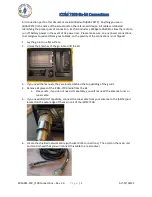
page 74
MARK-V FT-1000MP Operating Manual
EDSP N
OISE
R
EDUCER
Noise reduction is accomplished
by utilization of one of the four set-
tings selected by the front panel [NR]
button. Press the [NR] button to toggle
between Noise Reduction “A,” “B,”
“C,” “D,” and “OFF.” Each setting has
correlation parameters optimized to
reduce random noise, static, pulse/
man-made noise and heterodynes,
with little degradation of the desired
signal. As with the Contour feature, it
is difficult to predict which setting will be most effective
under current noise conditions, so experiment with the
settings as conditions change.
EDSP APF (A
UDIO
P
EAK
F
ILTER
)
In the CW mode, the front [APF]
button sets the bandwidth of the
EDSP’s CW peaking filter. Press the
[APF] button repeatedly to toggle be-
tween bandwidth selections “240 Hz,”
“120 Hz,” “60 Hz,” “DATA” (which is
optimized bandwidth for FAX,
PACKET or SSTV operation), and
“OFF.”
IDBT
(I
NTERLOCKED
D
IGITAL
B
ANDWIDTH
T
RACKING
) S
YSTEM
You can control the EDSP Contour’s “Bandpass”
filter characteristics according to the SHIFT and WIDTH
knobs’ settings. To do this, press the [IDBT] button on
the right side of the Shuttle Jog to activate the IDBS
feature. Doing so will automatically program the band-
width of the Bandpass Contour filter to match the IF
bandwidth set by these two controls; therefore, if you
have narrowed the IF passband to 1.9 kHz using the
WIDTH and SHIFT controls, the IDBT feature will au-
tomatically set the Contour filter’s Bandpass mode to
1.9 kHz, as well.
EDSP A
UTO
M
ULTIPLE
N
OTCH
F
ILTER
On page 48, we previously discussed basic IF notch
filter operation and how it is used to attenuate hetero-
dynes. EDSP offers multiple-notch capability within the
AF (rather than IF) bandpass with the press of a but-
ton. With the conventional (455 kHz 3rd IF) notch filter,
by comparison, only a single offending heterodyne at a
time can be attenuated by pressing the [NOTCH] but-
ton and slowly rotating the NOTCH control. Notch tun-
ing can sometimes be critical, as you have to position
the control for maximum “depth” by ear.
With the multiple notch, the EDSP circuitry exam-
ines the AF bandpass and the correlation of the sig-
nals present. After correlation parameters are com-
pared, unmodulated signals (heterodynes) are identi-
fied and notched out. As EDSP dynamically checks
the audio, new heterodynes will be identified and
notched, one by one, as they appear. See the illustra-
tion below.
Theoretically, an infinite amount of notches could
be inserted to attenuate each new heterodyne; how-
ever, the total notch bandwidth would approach that of
the audio passband, and, progressively notch all au-
dio. One limitation of the EDSP auto multiple notch fea-
ture is that it is only for use with SSB modes; attempt-
ing to use it on CW would cause the CW signals to
disappear -
not the desired function of a CW filter!
The effect of the EDSP notch filter will not be ob-
served on the S-meter, as the EDSP is outside of the
AGC circuit’s loop. The manual IF notch, however,
is
within the AGC loop, so you should use the IF notch
for particularly strong interference sources.
Advanced Features
EDSP
EDSP Auto Multiple Notch Action
















































